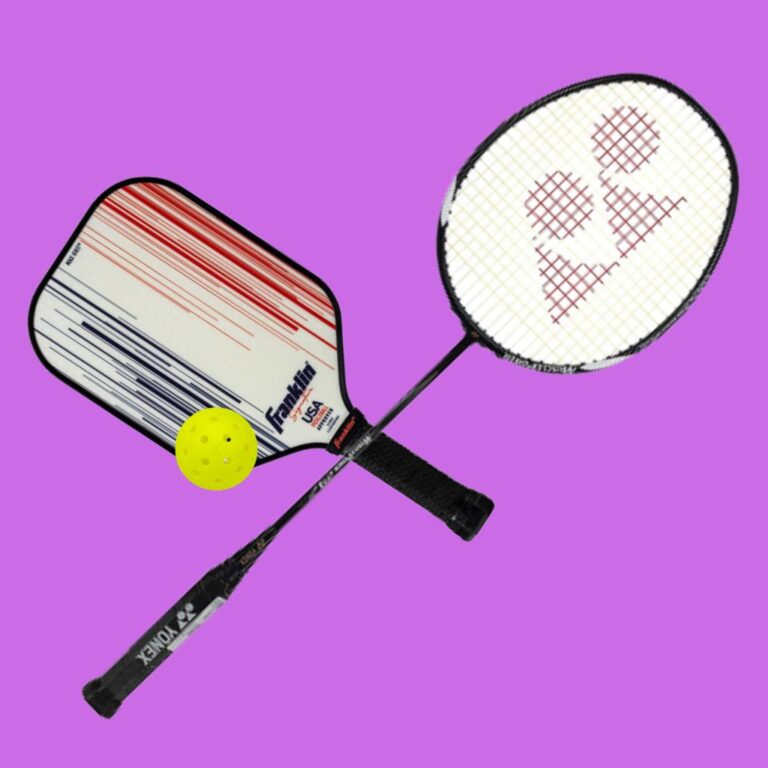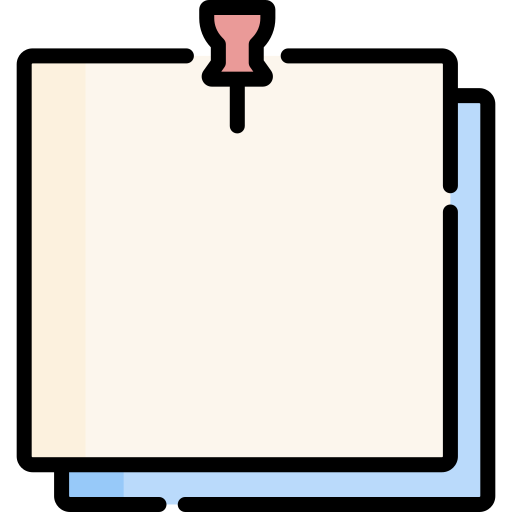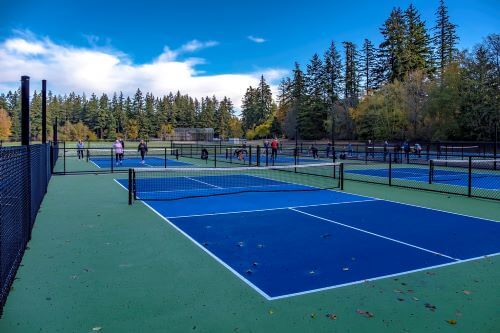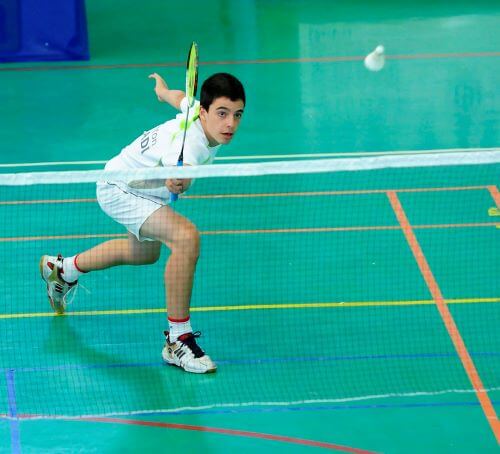
Pickleball vs badminton; which sport should you play?
If you’re a badminton player looking for an article that explains the difference between these two sports, I understand why you’re here. Pickleball’s popularity boomed over pretty much only several years, and now millions of enthusiasts are becoming advocates of the sport.
On the other hand, some of you are pickleball players who are thinking of trying out badminton. So, what really is the difference between these two sports? And, if you already know how to play pickleball, would you know how to play badminton too?
We’ll answer all these questions and more. Here are the differences and similarities of pickleball vs badminton: side by side.
Head to Head: Pickleball vs Badminton
Pickleball and badminton are two very developed sports, so their rulebooks are quite thick.

This is to make sure that the article doesn’t go over several thousand words in the process.
Pickleball vs Badminton Rulebook Comparison
The rulebook of these two sports is pretty thick, so we’ve collected, simplified, and segregated the information below.
Scoring in Pickleball vs Badminton
The first different thing between pickleball and badminton is their scoring. You need more points to win in badminton (21) compared to pickleball (11). In the case of a tie before the final point, both games follow the rule of winning by 2, wherein a team has to score two points in a row to win.

| Scoring | Badminton | Pickleball |
|---|---|---|
| Number of points to win | 21 points. In case of a tie at 20-20, a team must win 2 points in a row to close out and win the game | 11 points. If teams tie at 10-10, a team must win 2 points in a row to close out and win the game |
| Win by 2 rule | If a game is tied before the winning point, either team must win 2 rallies in a row (lead by 2 points) to close out the game. E.g. 22-20 or 13-15 | |
| Points awarded | 1 point to the team winning the rally | 1 point per winning rally if the rally is won as the serving team[*] |
| Point limit | Maximum of 30 points. The first team to reach 30 points regardless of the win-by-2 rule wins the game | No maximum number of points. Theoretically, a game can play even when the score is 50-50, as long as no team wins by 2 |
* In Pickleball, if the service team wins the rally, they get a point. If the service team loses the rally, the opponents do not get a point, but they become the service team and then have the chance to score a point by winning the rally as the service team.
E.g. Pickleball Rally Scoring Scenarios
| Scenario 1: Serving Team Wins Rally | Scenario 2: Serving Team Loses Rally |
|---|---|
| Team A is the serving team. They score a point on their serve. The score is now 1-0 for Team A.
They will continue to serve and score points until they commit a fault or lose the rally, at which point the opposing team will become the serving team. |
Team A is the serving team. They lose the rally to Team B. The score remains 0-0 even though Team B wins the rally because Team B was not the serving team.
Because Team B won the last rally, they are now the serving team. If Team B wins this rally as the serving team, the score becomes 0-1 in favor of Team B. |
This is why pickleball games take as long as badminton games, sometimes even longer., even though pickleball only needs half the points of badminton to close a game. Not only are rallies played back and forth with no one scoring, but pickleball also doesn’t have a point limit for the win by 2.

Serving in Pickleball vs Badminton
When it comes to serving, pickleball, and badminton have more similarities than differences. Servers are only allowed one service attempt, and the serves must be made diagonally crosscourt. The point of contact with the pickleball and shuttlecock is also below the waist when serving for both sports.

| Category | Pickleball | Badminton |
|---|---|---|
| Serving Area | The serve is made diagonally crosscourt and must land within the opponent’s diagonal court.
The server must stand behind the baseline, within the area of the centerline and sideline. |
The serve is made from a rectangular service court that is divided by a centerline.
The server must stand within the service court, and the serve must land inside the opponent’s service court. |
| Service Height | Paddle contact with the ball must be below waist level. The head of the paddle must not be above the highest part of the wrist at contact. | The shuttlecock must be struck below the server’s waist. |
| Faults on Serve | Both the server’s feet may not touch the court or outside the area between the sideline and centerline. At least one foot must be behind the baseline on the playing surface or the ground behind the baseline.
Only one serve attempt is allowed per server. |
The service cannot hit the net or it is considered a fault. With the point and service going to the opposing team.
The server cannot move its feet before hitting the shuttlecock. The serve must land within the service court diagonal to the server. Only one serve attempt is allowed. |
| Where to Serve | In singles, the server serves from the right/even court when their score is even and from the left/odd when the score is odd. If the server wins a rally, the server scores a point and then serves again from the alternate service court | |

When it comes to serving techniques though, pickleball and badminton share the basic types of serves:
- The drive or power serve: This is a fast and low serve that is hit with power and speed to give the opponent less time to react and prepare for the return shot.
- The lob serve: A high-arching serve hit softly and aimed near the back of the opponent’s court. It can be used to force opponents to move back and hit a weaker return shot while the server moves up.
- The spin serve: The serve is hit with spin, which can make the ball curve or bounce unpredictably, making it difficult for opponents to predict where to return.
- The drop shot serve: The serve is hit softly and aimed close to the net, forcing opponents to move forward and hit a difficult return shot.
- The short serve: The serve is hit aimed close to the net near the opponent’s feet. It can be used to catch opponents off-guard.
As you look into higher skill levels of the sport, there will be variations in the service. Like where to aim the shuttlecock or pickleball and how to flick your serves.
Rallies: Pickleball vs Badminton
The rules differ for rallies between pickleball and badminton. This is because the “ball” is very different, the shuttlecock and pickleball, and so the playstyle varies between sports.
In badminton, a rally ends in several ways, including when:
- The shuttlecock lands outside the boundaries of the court.
- The shuttlecock fails to pass over the net.
- The shuttlecock touches the ceiling or the walls.
- The shuttlecock touches the body or clothing of a player.
- A player touches the net with their body or racket.
- A player commits a fault, such as a service fault or a foot fault.
Whereas in pickleball, a rally ends when:
- The ball lands out of bounds.
- The ball is hit into the net or touches the net.
- A player fails to hit the ball before it bounces twice on their side of the court.
- A player hits the ball into the non-volley zone (also known as “the kitchen”) while volleying the ball.
- A player commits a fault, such as a foot fault or a double hit.

Side by Side: Pickleball vs Badminton Court Differences
Even though pickleball vs tennis is a more popular comparison, the pickleball court actually has more similarities with badminton than any of the other sports it’s inspired by.
| Aspect | Pickleball Court | Badminton Court |
|---|---|---|
| Court Dimensions | 44 x 20 ft (13.4 x 6.1 m) | 44 x 17 ft (13.4 x 5.18 m) |
| Net Height | 36 in (91.4 cm) | 5 ft at edges, 5 ft 1 in at center (152.4 cm at edges, 155 cm at center) |
| Court Surface | Hard or soft | Hard |
| Court Lines | White | White |
| Court Markings | Baseline, centerline, non-volley zone, service areas, sidelines | Baseline, center line, service lines, sidelines, shuttlecock service court |
| Non-Volley Zone | Yes (7 ft from the net or 2.1 m) | No |
The main difference between pickleball and badminton courts is the non-volley zone—which is one of the aspects that make pickleball interesting.
Gameplay Comparison: Pickleball vs Badminton
The gameplay difference between pickleball and badminton is where it differs the most.
To compare the gameplay evenly between both sports, we’ll divide the gameplay into multiple categories. The context of this gameplay is taken from the average of how veteran and professional players play the sport.
| Aspect | Pickleball | Badminton |
|---|---|---|
| Movement | Quick, lateral movements and frequent changes of direction. Players move mostly side-to-side, especially around the kitchen. | Requires fast and agile movements around the court, including jumps for smashes and often lunges to return shots. Players move in all directions. |
| Reaction Speed | Fast reflexes are necessary for both sports because their court sizes are identical. However, shuttlecocks move much faster than pickleball, especially during smashes.
Pickleballs typically travel between 35 to 65 miles per hour. Shuttlecocks move as fast as 160 to 220 miles per hour. The only reason why shuttlecocks can be returned in the first place is that they decelerate quickly. Still, a good smash will literally “blink” from the opponent’s racquet toward your area. |
|
| Pace | Fast-paced, with quick volleys and frequent net play.
Shorter-lasting rallies but longer games because of the side-out scoring system, where only the serving team can score. |
A mixture of fast- and slow-paced gameplay. The slow pace is caused by high volleys, but because of this setup smashes, the pace ramps up to 100 in a blink of an eye.
Rallies are generally longer in badminton. |
| Skill Level Required | Suitable for players of all skill levels, especially beginners. | Suitable for players of all skill levels, but requires a high level of technical skill and physical fitness to excel. |
| Physical Demands | Moderate to a high level of physical activity, including fast movements and quick changes of direction. | High level of physical activity, including jumping and lunging. Requires good endurance and stamina. |
| Strategy and Tactics | Involves a variety of strategies and tactics, such as dinking, lobbing, and serving techniques.
The unique thing about pickleball is that players need to be aware of the non-volley zone and play around it. |
Requires a high degree of strategic thinking and tactical decision-making, including net play, drops, smashes, and defensive strategies. |
| Spectator Appeal | Exciting and engaging to watch, with frequent fast-paced action and strategic shots. | Exciting and engaging to watch, with high-flying shuttlecocks and long rallies.
It is worth stating however that live broadcasts do not capture the strength and speed of these players and their shots effectively. It’s a similar problem with tennis where the ball looks “slow”, but in reality, is blindingly fast. |
Comparing the gameplay to pickleball and badminton, however, shouldn’t be a case of which is better. Both of these sports are simply different. Badminton was invented in India and played by the British soldiers stationed there. Pickleball was invented in a congressman’s backyard to entertain their families over a long weekend.
Pickleball was never meant to compete with badminton and it shouldn’t be held to that standard. The same goes for tennis and ping pong.
Pickleball vs Badminton: What You Need to Play
Moving on to the equipment, pickleball vs badminton: the cost to play.

| Pickleball Gear Summary | ||
|---|---|---|
| Gear | Prices | Lifespan |
| Paddle | $50 – $100 | 2-5 years depending on usage and maintenance |
| Balls | $20 – $40 | 10-15 games, depending on quality and usage |
| Net | $80 – $150 | 3-5 years depending on usage and maintenance |
Surprisingly, the cost of playing badminton and pickleball is similar at the start.

| Badminton Gear Summary | ||
|---|---|---|
| Gear | Prices | Lifespan |
| Racket | $50 – $100 | 2-3 years depending on usage and maintenance |
| Shuttlecocks | $20 – $40 | 1-2 games depending on quality, playing conditions, and usage |
| Net | $80 – $150 | 3-5 years depending on usage and maintenance |
However, after several games, badminton starts becoming more expensive. While shuttlecocks are similarly priced to pickleballs, these shuttlecocks break very quickly. This is mainly due to the design and composition of the shuttlecocks since the brittle features can chip away and reduce performance.
Is Pickleball More Popular than Badminton?
Not even close. Badminton is far more the popular sport of the two. Here are some statistics taken from the Badminton World Federation and the International Federation of Pickleball.
| Category | Badminton | Pickleball |
|---|---|---|
| Number of players | 300 million | 3 million |
| Number of countries playing | 170+ | 60+ |
| Number of professionals | 1,500 | Approximately 100 |
As you can see, pickleball still has quite a long way to go before it can compete with badminton. In fact, badminton is arguably even more popular than tennis globally. Tennis is mainly a Western sport though, so the media coverage for it is bigger in America.
The History of Pickleball and Badminton
Badminton originated in the 1800s in India, where it was played together with British soldiers who were stationed there. During the mid-1900s, badminton was incorporated into British culture as a garden sport for the higher class. Modern-day badminton is closer to the British version than the sport from India.
Pickleball, on the other hand, starts its humble beginnings in Bainbridge Island, Washington. Congressman Joel Pritchard and his friend—Bill Bell—were together with their families, bored over the weekend. The group decided to play some badminton, improvising it with ping pong paddles and a plastic ball instead.
That’s how pickleball started.
Is Pickleball Harder than Badminton?
It depends on how you plan on playing.
At the professional level, badminton is much harder. It’s a more physically demanding sport, requiring players to jump, lunge, and have lightning-fast reflexes to return smashes.
In the intermediate level, when smashes are still there, badminton is still a harder, physical sport.
However, for beginners, pickleball is actually harder than badminton. In a way, it’s more fun as well. Pickleball lets players from all sorts of physical backgrounds enjoy the game and make technical shots, like dinks or lobs, easier. In turn, this makes playing the game more challenging because both teams can do technical shots easier.
Beginner badminton is pretty much all about hitting the shuttlecock back and forth. There’s not much strategy to it after that.



